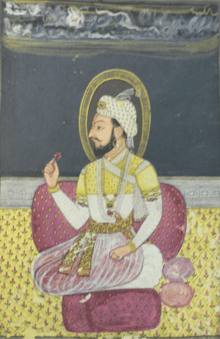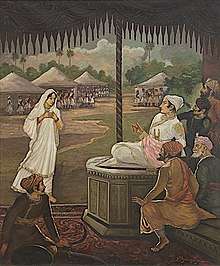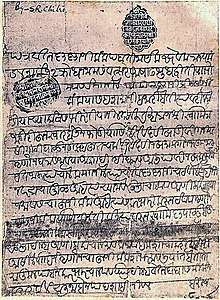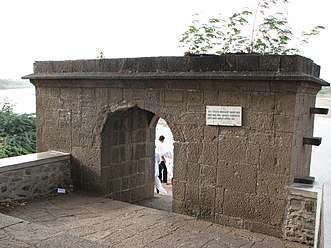Sambhaji
Sambhaji Bhosale (14 May 1657 – 11 March 1689) was the second ruler of the Maratha kingdom. He was the eldest son of Shivaji, the founder of the Maratha Empire and his first wife Saibai. He was successor of the realm after his father's death, and ruled it for nine years. Sambhaji's rule was largely shaped by the ongoing wars between the Maratha kingdom and Mughal Empire as well as other neighbouring powers such as the Siddis, Mysore and the Portuguese in Goa. In 1689, Sambhaji was captured, tortured and executed by the Mughals, and succeeded by his brother Rajaram I.[1]
| Sambhaji | |
|---|---|
| Chhatrapati of the Maratha Empire | |
 A painting of Sambhaji, late 17th century | |
| Reign | 16 January 1681 – 11 March 1689 |
| Coronation | 20 July 1680, Panhala or 16 January 1681, Raigad fort |
| Predecessor | Shivaji I |
| Successor | Rajaram I |
| Born | 14 May 1657 Purandar Fort, near Pune, India |
| Died | 11 March 1689 (aged 31) Tulapur-Vadhu Dist. Pune, Maharashtra, India |
| Spouse | Yesubai |
| Issue | Bhavani Bai Shahu I |
| House | Bhonsle |
| Father | Shivaji I |
| Mother | Saibai |
| Religion | Hinduism |
Early life
Sambhaji was born at Purandar fort to Saibai, Shivaji's first wife. His mother died when he was two years old and he was raised by his paternal grandmother Jijabai.[2] At the age of nine, Sambhaji was sent to live with Raja Jai Singh I of Aamer as a political hostage to ensure compliance of the Treaty of Purandar that Shivaji had signed with the Mughals on 11 June 1665. As a result of the treaty, Sambhaji became a Mughal mansabdar.[3] He and his father Shivaji presented themselves at Mughal emperor, Aurangzeb's court at Agra on 12 May 1666. Aurangzeb put both of them under house arrest but they escaped on 22 July 1666.[4] However, the two sides reconciled and had cordial relations during the period 1666–1670. In this period Shivaji and Sambhaji fought alongside the Mughals against the Sultanate of Bijapur.[3]
Marriage
Sambhaji was married to Jivubai in a marriage of political alliance; per Maratha custom she took the name Yesubai. Jivubai was the daughter of Pilajirao Shirke, who had entered Shivaji's service following the defeat of a powerful deshmukh Rao Rana Suryajirao Surve who was his previous patron. This marriage thus gave Shivaji access to the Konkan coastal belt.[5][6] Yesubai gave birth to a daughter named Bhavani Bai and then to a son named Shahu.
House arrest and defection to the Mughals
Sambhaji's behaviour, including alleged irresponsibility and addiction to sensual pleasures led Shivaji to imprison his son at Panhala fort in 1678 to curb his behaviour.[5][7] Sambhaji escaped from the fort with his wife and defected to the Mughals in December 1678 for a year, but then returned home when he learnt of a plan by Dilir Khan, the Mughal viceroy of Deccan to arrest him and send him to Delhi.[8] Upon returning home, Sambhaji was unrepentant and was put under surveillance at Panhala.[5][9]
Accession

When Shivaji died in the first week of April 1680, Sambhaji was still held captive at Panhala fort. Some of the influential sardars including ministers Annaji Datto and other ministers conspired against Sambhaji, supported by Soyarabai, to prevent Sambhaji from succeeding the throne.[5]:48 Shivaji's widow and Sambhaji's stepmother, Soyrabai after her husband's death installed the couple's son, Rajaram, a lad of 10, on the throne on 21 April 1680.[10] Upon hearing this news, Sambhaji plotted his escape and took possession of the Panhala fort on 27 April after killing the fort commander. On 18 June, he acquired control of Raigad fort. Sambhaji formally ascended the throne on 20 July 1680. Rajaram, his wife Janki Bai and mother Soyarabai were imprisoned. Soon after their another conspiracy attempt against Sambhaji using prince Akbar,[11] Aurangzeb's fourth son, Soyarabai, her kinsmen from the Shirke family and some of Shivaji's ministers such as Annaji Datto were executed on charges of conspiracy.[5]:48[12]
Military expeditions and conflicts
Shortly following Sambhaji's accession, he began his military campaigns against neighboring states. Historians have been quick to note the distinction between the more tolerant and chivalrous practices of his father Shivaji, and the more pragmatic and brutal practices of Sambhaji.
Attack on Burhanpur
Bahadur Khan was first in charge of The fort of Burhanpur who later gave it to Kakar Khan. Kakar was at the duty of collecting jizya tax from the citizens. The Jizya was collected and stored captive at the Burhanpur fort. Sambhaji plundered and ravaged Burhanpur in 1680. His forces completely routed the Mughal garrison and punitively executed captives. The Marathas then looted the city and set its ports ablaze. Sambhaji then withdrew into Baglana, evading the forces of Mughal commander Khan Jahan Bahadur.[13]:218 During the attack on Burhanpur, among Sambhaji's 20,000 troops, many of them perpetrated atrocities against Muslims, including plunder, killing, and torture.[13]
Mughal Empire
In 1681, Aurangzeb's fourth son Akbar left the Mughal court along with a few Muslim mansabdar supporters and joined Muslim rebels in the Deccan. Aurangzeb in response moved his court south to Aurangabad and took over command of the Deccan campaign. The rebels were defeated and Akbar fled south to seek refuge with Sambhaji. Sambhaji's ministers including Annaji Datto, and other ministers took this opportunity and conspired again to enthrone Rajaram again. They signed a treasonable letter against Sambhaji in which they promised to join Akbar, to whom the letter was sent.[14][15] Akbar gave this letter to Sambhaji.[14] Enraged, Sambhaji executed conspirators on charges of treason.[16]
For five years, Akbar stayed with Sambhaji, hoping that the latter would lend him men and money to strike and seize the Mughal throne for himself. Unfortunately for Sambhaji, giving asylum to Akbar did not bear fruit. Eventually, Sambhaji helped Akbar flee to Persia. On the other hand, Aurangzeb after coming to Deccan never returned to his capital in the north.[17][18]
In 1682, the Mughals laid siege to the Maratha fort of Ramsej, but after five months of failed attempts, including planting explosive mines and building wooden towers to gain the walls, the Mughal siege failed.[19]
Siddis of Janjira
The Marathas under Shivaji came into conflict with the Siddis, Muslims of Abyssinian descent settled in India, over the control of the Konkan coast. Shivaji was able to reduce their presence to the fortified island of Janjira. Sambhaji continued the Maratha campaign against them, while at that time the Siddis formed an alliance with the Mughals.[20] At the start of 1682, a Maratha army later joined by Sambhaji personally, attacked the island for thirty days, doing heavy damage but failing to breach its defenses. Sambhaji then attempted a ruse, sending a party of his people to the Siddis, claiming to be defectors. They were allowed into the fort and planned to detonate the gunpowder magazine during a coming Maratha attack. However, one of the female defectors became involved with a Siddi man and he uncovered the plot, and the infiltrators were executed. The Maratha then attempted to build a stone causeway from the shore to the island, but were interrupted halfway through when the Mughal army moved to menace Raigad. Sambhaji returned to counter them and his remaining troops were unable to overcome the Janjira garrison and the Siddi fleet protecting it.[21]
Portuguese and English

Having failed to take Janjira in 1682, Sambhaji sent a commander to seize the Portuguese coastal fort of Anjadiva instead. The Marathas seized the fort, seeking to turn it into a naval base, but in April 1682 were ejected from the fort by a detachment of 200 Portuguese. This incident led to a larger conflict between the two regional powers.[21]:171
The Portuguese colony of Goa at that time provided supplies to the Mughals, allowed them to use the Portuguese ports in India and pass through their territory. In order to deny this support to the Mughals, Sambhaji undertook a campaign against Portuguese Goa in late 1683, storming the colony and taking its forts.[22] The situation for the colonists became so dire that the Portuguese viceroy, Francisco de Távora, conde de Alvor went with his remaining supporters to the cathedral where the crypt of Saint Francis Xavier was kept, where they prayed for deliverance. The viceroy had the casket opened and gave the saint's body his baton, royal credentials and a letter asking the saint's support. Sambhaji's Goa campaign was checked by the arrival of the Mughal army and navy in January 1684, forcing him to withdraw.[23]
Meanwhile, in 1684 Sambhaji signed a defensive treaty with the English at Bombay, realising his need for English arms and gunpowder, particularly as their lack of artillery and explosives impeded the Maratha's ability to lay siege to fortifications. Thus reinforced, Sambhaji proceeded to take Pratapgad and a series of forts along the Ghats.[24]:91
Mysore
Much like his father Shivaji's Karnataka campaign, Sambhaji attempted in 1681 to invade Mysore, then a southern principality ruled by Wodeyar Chikkadevaraja. Sambhaji's large army was repelled,[24]:91 as had happened to Shivaji in 1675.[25] The Chikkadevraja later made treaties and rendered tribute to the Maratha kingdom during the conflicts of 1682–1686. The Chikkadevraja however began to draw close to the Mughal empire and ceased to follow his treaties with the Marathas. In response, Sambhaji invaded Mysore in 1686, accompanied by his Brahmin friend and poet Kavi Kalash.[26][27]
Capture and execution

The 1687 Battle of Wai saw the Maratha forces badly weakened by the Mughals. The key Maratha commander Hambirao Mohite was killed and troops began to desert the Maratha armies. Sambhaji's positions were spied upon by his own relations, the Shirke family, who had defected to the Mughals. Sambhaji and 25 of his advisors were captured by the Mughal forces of Muqarrab Khan in a skirmish at Sangameshwar in February 1689.[5]:47
Accounts of Sambhaji's confrontation with the Mughal ruler and following torture, execution and disposal of his body, vary widely depending on the source, though generally all agree that he was tortured and executed on the emperor's orders.[5]:50
The captured Sambhaji and Kavi Kalash were taken to Bahadurgad in present-day Ahmednagar district, where Aurangzeb humiliated them by parading them wearing clown's clothes and they were subjected to insults by Mughal soldiers. Accounts vary as to the reasons for what came next: Mughal accounts state that Sambhaji was asked to surrender his forts, treasures and names of Mughal collaborators with the Marathas and that he sealed his fate by insulting both the emperor and the Islamic prophet Muhammad during interrogation and was executed for having killed Muslims.[28] The ulema of the Mughal Empire sentenced Sambhaji to death for the atrocities his troops perpetrated against Muslims in Burhanpur, including plunder, killing, rape, and torture.[13]
Maratha accounts instead state that he was ordered to bow before Aurangzeb and convert to Islam and it was his refusal to do so, by saying that he would accept Islam on the day the emperor presented him his daughter's hand, that led to his death.[29] By doing so he earned the title of Dharmaveer ("protector of dharma").[30] Aurangzeb ordered Sambhaji and Kavi Kalash to be tortured to death; the process took over a fortnight and included plucking out their eyes and tongue, pulling out their nails and removing their skin. Sambhaji was finally killed on 11 March 1689,[31] reportedly by tearing him apart from the front and back with wagh nakhe (metal "tiger claws") and beheading with an axe at Tulapur on the banks of the Bhima river near Pune.[5]:50
Other accounts state that Sambhaji challenged Aurangzeb in open court and refused to convert to Islam. Dennis Kincaid writes, "He (Sambhaji) was ordered by the Emperor to embrace Islam. He refused and was made to run the gauntlet of the whole Imperial army. Tattered and bleeding he was brought before the Emperor and repeated his refusal. His tongue was torn and again the question was put. He called for writing material and wrote 'Not even if the emperor bribed me with his daughter!' So then he was put to death by torture".[30]
Some accounts state that Sambhaji's body was cut into pieces and thrown into the river or that the body or portions were recaptured and cremated at the confluence of rivers at Tulapur.[32][33] Other accounts state that Sambhaji's remains were fed to the dogs.[34]
Governance
Sambhaji inherited the governance system created by Shivaji. He continued with most of his father's policies. The administration of the state was managed by Sambhaji with the help of Chandogamatya and the council of eight ministers.[35] According to P.S.Joshi Sambhaji was a good administrator who gave impartial justice to his subjects.[36]
Measures against drought
Maharashtra witnessed severe drought during the reign of Sambhaji (1684-88). Sambhaji had to take several administrative measures to tackle the situation.
Sambhaji continued Shivaji's policies by helping poor farmers. Shankar Narayan Joshi has stated that his approach against famine was very constructive and he provided solutions to many complicated problems. His policies of water storage, irrigation and developing crop patterns show about his progressive policies.[37]
Sambhaji, much like modern times provided grain seeds, exemptions in taxes, oxen for agricultural work and agricultural tools to the farmers in the drought situation. All these measures were implemented sincerely during the drought period.[32]
Encouragement to Agricultural activities
Sambhaji encouraged the agricultural activity in the Maratha state. Agriculture was the backbone of the rural Maratha economy. He encouraged people to cultivate more and more land. The government of Sambhaji gave promises of safety to the Marathas who had returned to the swarajya from the Mughal side and asked them to carry out their previous work of cultivation in their territories. It also called back the people who had absconded because of their inability to pay taxes and asked them carry out their previous work of cultivation.[37]
Sambhaji in his letter of 3rd June, 1684 addressed to Hari Shivdev (Subhedar and Karkun of Tarf Chaul), his Peshwa Nilkantha Moreshwar directed him to bring the agricultural land of the villages confiscated by the government under cultivation which otherwise would have remained uncultivated. He also asked Hari Shivdev to distribute fifty khandis of grain which were being sent to him from Sagargad among the cultivators.[37]
Sambhaji tried to increase the income (revenue) from the agricultural activities. He also made efforts to cultivate more wasted or barren lands.[32]
Religious policy
P.S.Joshi states that Sambhaji, his ministers and officers took interest in supporting the cultural and religious activity in the state. They honoured and encouraged learning by granting land, grains and money to scholars.[36]
Literary contributions
Sambhaji was sophisticated, educated and well-versed in a few languages other than Marathi. Keshav Pandit was employed for Sambhaji's education. Keshav Pandit, alias Keshav Bhatta of Shringarpur, was an erudite scholar in the Nitishastra and Sanskrit language and literature. He seems to have deeper knowledge of the different forms of Sanskrit literature; Hindu jurisprudence and the Puranas. He also seems to have made Sambhaji familiar with the famous works of different sciences and music written by ancient scholars in the Sanskrit language.[2][38]
There are several books by Sambhaji. The most notable is Budhbhushanam which is in Sanskrit and three other known books Nayikabhed, Saatsatak, Nakhshikha are in Hindi language.[39] In Budhbhushanam, Sambhaji wrote poetry on politics. In the book Sambhaji writes about dos and don'ts for a king and discusses military tactics. The first few slokas are praises for Shahaji (his grandfather) and his father Shivaji. In Budhbhushan Sambhaji considers Shivaji to be the incarnation that saved the earth and restored righteousness.[40]
Innovations
Sambhaji is used to have used many Innovations during his campaigns, one such innovation was when is made jackets made from leather for his soldiers for protection from lethal arrows fired by the Mysore army during his campaign against Mysore,it was highly successful as after the initial retreat of the Maratha army due to the poisonous arrows was converted into a victory by the use of these leather jackets.
He also came to an idea of building a causeway in the sea from Rajapuri to the gate of Janjira for defeating the siddis of Janjira, it is said that he had even built a causeway of 800 meters but he could not proceed further due to Mughal invansion on other side of the Kingdom.
Succession
The Maratha Kingdom was put into disarray by Sambhaji's death and his younger half-brother Rajaram Chhatrapati assumed the throne. Rajaram shifted the Maratha capital far south to Jinji, while Maratha guerrilla fighters under Santaji Ghorpade and Dhanaji Jadhav continued to harass the Mughal army. A few days after Sambhaji's death, the capital Raigad Fort fell to the Mughals. Sambhaji's widow, Yesubai, son, Shahu and Shivaji's widow, Sakvarbai were captured; Sakvarbai died in Mughal captivity.[41] Shahu, who was seven years of age when captured, remained prisoner of the Mughals for 18 years from February 1689 until Mughal Emperor Aurangzeb's death in 1707. Shahu was then set free by Emperor Muhammad Azam Shah, son of Aurangzeb. After his release Shahu had to fight a brief war with his aunt Tarabai, Rajaram's widow who claimed the throne for her own son, Shivaji II.[42][43][44] The Mughals kept Yesubai captive to ensure that Shahu adhered to the terms of his release. She was released in 1719 when Marathas became strong enough under Shahu and Peshwa Balaji Vishwanath.[45]
| Preceded by Shivaji |
Chhatrapati of the Maratha Empire 1680–1689 |
Succeeded by Rajaram |
References
- Sen, Sailendra (2013). A Textbook of Medieval Indian History. Primus Books. pp. 199–200. ISBN 978-9-38060-734-4.
- Joshi, Pandit Shankar (1980). Chhatrapati Sambhaji, 1657–1689 A.D. S. Chand. pp. 4–5.
- Rana, Bhawan Singh (2004). Chhatrapati Shivaji (1st ed.). New Delhi: Diamond Pocket Books. p. 64. ISBN 8128808265.
- Gordon, Stewart (1993). The Marathas 1600–1818 (1st publ. ed.). New York: Cambridge University. pp. 74–78. ISBN 978-0-521-26883-7. Retrieved 5 June 2016.
- J. L. Mehta (1 January 2005). Advanced Study in the History of Modern India: Volume One: 1707 – 1813. Sterling Publishers Pvt. Ltd. p. 4,47. ISBN 978-1-932705-54-6. Retrieved 7 April 2016.
- Rana, Bhawan Singh (2004). Chhatrapati Shivaji (1st ed.). New Delhi: Diamond Pocket Books. pp. 96–99. ISBN 81-288-0826-5. Retrieved 26 July 2016.
- Govind Sakharam Sardesai (1946). New History of the Marathas. Phoenix Publications. p. 230.
- Bhave, Y.G. (2000). From the death of Shivaji to the death of Aurangzeb : the critical years. New Delhi: Northern Book Centre. p. 35. ISBN 81-7211100-2.
- Gordon, Stewart (1993). The Marathas 1600–1818 (1. publ. ed.). New York: Cambridge University. p. 80. ISBN 978-0-521-26883-7. Retrieved 5 June 2016.
- Gordon, Stewart (1993). The Marathas 1600–1818 (1st publ. ed.). New York: Cambridge University. p. 91. ISBN 978-0-521-26883-7. Retrieved 5 June 2016.
- Pāṭīla, Śālinī (1987). Maharani Tarabai of Kolhapur, c. 1675–1761 A.D. S. Chand & Co. ISBN 9788121902694.
- Sunita Sharma; K̲h̲udā Bak̲h̲sh Oriyanṭal Pablik Lāʼibrerī (2004). Veil, sceptre, and quill: profiles of eminent women, 16th- 18th centuries. Khuda Bakhsh Oriental Public Library. p. 139. Retrieved 30 September 2012. – By June 1680 three months after Shivaji's death Rajaram was made a prisoner in the fort of Raigad."
- John F. Richards (1995). The Mughal Empire. Cambridge University Press. p. 217-223.
- Pāṭīla, Śālinī (1987). Maharani Tarabai of Kolhapur, c. 1675-1761 A.D. S. Chand & Co. ISBN 9788121902694.
- Gokhale, Kamal Shrikrishna (1978). Chhatrapati Sambhaji. Navakamal Publications.
- Gokhale, Kamal Shrikrishna (1978). Chhatrapati Sambhaji. Navakamal Publications.
- Gascoigne, Bamber; Gascoigne, Christina (1971). The Great Moghuls. Cape. pp. 228–229.
- Kulkarni, A.R. (2008). The Marathas (1st ed.). Pune: Diamond Publications. ISBN 9788184830736.
- Itihas. Director of State Archives, Government of Andhra Pradesh. 1976. pp. 100–103. Retrieved 3 August 2013.
- Kumar, Amarendra (2014). "Keigwin's Bombay (1683-84) and the Maratha-Siddi Naval Conflict". Proceedings of the Indian History Congress. 75: 320–324. JSTOR 44158397.
- Shanti Sadiq Ali (1 January 1996). The African Dispersal in the Deccan: From Medieval to Modern Times. Orient Blackswan. pp. 171–. ISBN 978-81-250-0485-1. Retrieved 1 October 2012.
- Glenn Joseph Ames (2000). Renascent Empire?: The House of Braganza and the Quest for Stability in Portuguese Monsoon Asia c. 1640–1683. Amsterdam University Press. pp. 155–. ISBN 978-90-5356-382-3.
- Dauril Alden (1 September 1996). The Making of an Enterprise: The Society of Jesus in Portugal, Its Empire, and Beyond, 1540–1750. Stanford University Press. pp. 202–. ISBN 978-0-8047-2271-1. Retrieved 2 October 2012.
- Stewart Gordon (16 September 1993). The Marathas 1600–1818. Cambridge University Press. pp. 91–. ISBN 978-0-521-26883-7. Retrieved 2 October 2012.
- Pran Nath Chopra (1992). Encyclopaedia of India: Karnataka. Rima Pub. House. Retrieved 2 October 2012.
- B. Muddhachari (1969). The Mysore-Maratha relations in the 17th century. Prasārānga, University of Mysore. p. 106. Retrieved 2 October 2012.
- A. Satyanarayana; Karnataka (India). Directorate of Archaeology & Museums (1996). History of the Wodeyars of Mysore, 1610–1748. Directorate of Archaeology and Museums. p. 94. Retrieved 2 October 2012.
- Richards, John F. (26 January 1996). The Mughal Empire. Cambridge University Press. p. 223. ISBN 978-0-521-56603-2. Retrieved 29 September 2012.
- S. B. Bhattacherje (1 May 2009). Encyclopaedia of Indian Events & Dates. Sterling Publishers Pvt. Ltd. pp. A80–A81. ISBN 978-81-207-4074-7. Retrieved 6 March 2012.
- Y. G. Bhave (1 January 2000). From the Death of Shivaji to the Death of Aurangzeb: The Critical Years. Northern Book Centre. pp. 60–. ISBN 978-81-7211-100-7. Retrieved 2 October 2012.
- "Maasir – I – Alamgiri". archive.org. Retrieved 14 May 2017.
- Gokhale, Kamal Shrikrishna (1978). Chhatrapati Sambhaji. Pune: Navakamal Publications. p. 23.
- Organiser. Bharat Prakashan. January 1973. p. 280. Retrieved 2 October 2012. – When they were finally thrown away, the Marathas brought Sambhaji's head to Tulapur and consigned if to fire at the confluence of the Bheema and Indrayani rivers.
- J. L. Mehta (1 January 2005). Advanced Study in the History of Modern India: Volume One: 1707 – 1813. Sterling Publishers Pvt. Ltd. p. 50. ISBN 978-1-932705-54-6. Retrieved 7 April 2016.
- Kulkarni, A.R. (1969). Maharashtra Under the Age of Shivaji : A Study in Economic History. Pune: Deshmukh & Co. Publishers. p. 3. ISBN 9788174340894.
- Joshi, Pandit Shankar (1980). Chhatrapati Sambhaji. New Delhi: S. Chand and Co. p. 285. ISBN 978-0861864454.
- Joshi, Shankar Narayan (2015). Sambhajikalin patrasarsangraha ( shake1602- shake1610). Pune: Bharata Itihasa Sanshodaka Mandala. p. 39.
- "Budhabhushanam Of Shambhuraja HD Velankar BORI 1926". archive.org. Retrieved 7 April 2018.
- "Budhabhushanam Of Shambhuraja HD Velankar BORI 1926". archive.org. Retrieved 7 April 2018.
- "Budhabhushanam Of Shambhuraja HD Velankar BORI 1926". archive.org. Retrieved 7 April 2018.
- Mehta, J. L. (2005). Advanced study in the history of modern India, 1707–1813. Slough: New Dawn Press, Inc. p. 47. ISBN 9781932705546.
- Manohar, Malgonkar (1959), The Sea Hawk: Life and Battles of Kanoji Angrey, p. 63
- A. Vijaya Kumari; Sepuri Bhaskar (1998). Social change among Balijas: majority community of Andhra Pradesh. MD. ISBN 9788175330726. Retrieved 24 June 2011.
- Sen, Sailendra (2013). A Textbook of Medieval Indian History. Primus Books. pp. 201–202. ISBN 978-93-80607-34-4.
- The Quarterly Review of Historical Studies. Institute of Historical Studies. 1971.
| Wikimedia Commons has media related to Sambhaji. |